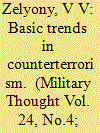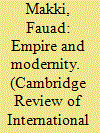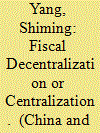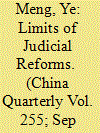|
|
|
Sort Order |
|
|
|
Items / Page
|
|
|
|
|
|
|
| Srl | Item |
| 1 |
ID:
143699


|
|
|
|
|
| Summary/Abstract |
The National Security Strategy of the Russian Federation up to 2020 calls terrorism one of the global challenges of our day.1 The 9/11 terrorist attacks in the U.S. in 2001 introduced totally new approaches to the fight against terrorism. Terrorism, though, has been carried on in many more countries - its latest blows fell in Grozniy, Russia's Northern Caucasus, in December 2014, and in Paris in January 2015, a sign that counterterrorist policies have to be given a major refit. Here in Russia, the domestic counterterrorist policy needs an injection of foreign experience to be put on a sound scientific plateau.2 The refit can facilitate examination of counterterrorism as it is practiced on the ground and help basic counterterrorist trends to be identified. In turn, with the trends set, the efforts of international organizations and national authorities will be tuned up and geared to forestalling and fighting terrorism.
|
|
|
|
|
|
|
|
|
|
|
|
|
|
|
|
| 2 |
ID:
100999


|
|
|
|
|
| Publication |
2010.
|
| Summary/Abstract |
This article examines central-provincial relations in the context of greater centralization. Focusing on the background of provincial leaders, the leadership management system, and the fiscal system, it suggests that there has been an unmistakable trend toward greater central control. However, greater centralization has coexisted with decentralization in many areas of governance. While greater centralization has not completely changed the particularistic character of central- provincial interactions, the arena has shifted to bargaining and lobbying for central largess. Provincial bargaining now occurs in a context in which the central government is in control of considerably greater resources and more capable of setting the rules of the game. This study of the central-provincial relations helps to contextualize the study of Hong Kong's relationship with Beijing first by pointing to their different natures and characters. At the same time, salient developments in central-provincial relations in the main body politics also form the context for Hong Kong's relationship with Beijing.
|
|
|
|
|
|
|
|
|
|
|
|
|
|
|
|
| 3 |
ID:
070077


|
|
|
| 4 |
ID:
193190


|
|
|
|
|
| Summary/Abstract |
Decentralized court finance and personnel management practices have been criticized for breeding extra-judicial interventions and corruption in China. Determined to advance law-based governance and to constrain recalcitrant local leaders, the Chinese leadership under Xi Jinping in 2014 rolled out reforms to centralize local court finance to the provincial level with the aim to sever local courts from local influence. Despite high expectations, implementation is at best partial. Close to half of all provinces have not accomplished the required changes, and more than half of all court expenditure continues, to date, to remain reliant upon local governments. The direct reason is that provincial governments lack sufficient and sustainable fiscal capacity to finance the operation of local courts without central assistance. Different interests between major stakeholders, namely the courts and the fiscal bureaus, also add to coordination problems and difficulties in reform implementation, in particular the tension between fiscal adequacy pursued by the judiciary and fiscal management efficiency stressed by finance bureaus.
|
|
|
|
|
|
|
|
|
|
|
|
|
|
|
|
| 5 |
ID:
179292


|
|
|
|
|
| Summary/Abstract |
The local party-state has always been a major source of extrajudicial influence in China. Drawing on interviews with judges, this article examines the impact of Xi Jinping's ambitious judicial centralization reforms, which are aimed at enhancing judicial autonomy by transferring authority over local court personnel and finances from local to provincial level. It finds that the reforms have achieved limited results. Although many appointment and budgetary powers were formally transferred to the provincial level, the local party-state retains considerable influence in both areas owing to its superior manpower, local knowledge and, in the case of developed regions, financial resources. Moreover, the local party-state maintains significant informal influence over the courts, which require many forms of discretionary assistance from various state organs – ranging from appropriating land for new courthouses to providing police protection for remote tribunals – in order to function. This setback highlights the depth and complexity of the courts’ political and economic embeddedness and serves as a reminder of the inherent difficulty of institutionalizing judicial autonomy, however limited, in a large and diverse party-state.
|
|
|
|
|
|
|
|
|
|
|
|
|
|
|
|
| 6 |
ID:
106962


|
|
|
|
|
| Publication |
2011.
|
| Summary/Abstract |
Conventional accounts of modern state-formation either underplay its contradictory and variegated character or neglect its international dimensions. Against these approaches, alternative theories of state-formation have emerged centred on the constitutive significance of intersocietal relations and differential temporalities. This article develops the latter approaches in relation to the Ethiopian state. Contrary to widespread assumptions of Ethiopia's political insularity, it suggests that at three crucial turning points geopolitical exigencies provided the critical impetus for the political and cultural reconstitution of the state. Late nineteenth century European colonial encroachment triggered a reaction in the form of an Ethiopian imperial expansion to rival them. And the political shock of Italian occupation 40 years later provoked a concurrent project of dynastic centralization and official nationalism in the post-restoration period. But precisely because divine monarchy and nationalism are antithetical orders by virtue of their opposed principles of sovereignty, the attempt to conjoin them generated deep social and cultural contradictions that erupted in two successive revolutions that were internationally overdetermined and resulted in a profound reconstitution of the Ethiopian state.
|
|
|
|
|
|
|
|
|
|
|
|
|
|
|
|
| 7 |
ID:
167888


|
|
|
|
|
| Summary/Abstract |
If fiscal decentralization promotes growth, why do some regions decentralize more than others? This article identifies the growing divergence of fiscal centralization among Chinese cities and explains it in a public finance framework. It argues that fiscal decentralization and its economy‐liberalizing effect entail significant short‐term fiscal risk. The more a locality relies on uncompetitive business ownership for fiscal revenue, the less likely fiscal decentralization is to occur. This article compiles a dataset of 20 provincial capitals between 1999 and 2016 to test for the connection between a city's tax base and its fiscal centralization level. It then pairs two “most similar” cities to trace how fiscal security concerns drove their fiscal and economic policies apart. This article adds a micro‐level perspective to the literature on fiscal federalism. By pointing out the fiscal constraints confronting local governments, it offers a new angle to understand the different growth paths of Chinese cities.
|
|
|
|
|
|
|
|
|
|
|
|
|
|
|
|
| 8 |
ID:
098172


|
|
|
| 9 |
ID:
119206


|
|
|
|
|
| Publication |
2013.
|
| Summary/Abstract |
Is centralized teacher deployment more equitable? This paper evaluates the teacher deployment centralization reform on teacher allocation in the context of rural China. Since 2001 the administration of regular teacher deployment has been gradually moved from the township (or local school district) up to the county government. Using the data from an impoverished province, I show that deployment centralization tends to exacerbate existing inequality in the allocation of teachers in favor of communities close to the county seat by exploiting variations in the timing of centralization.
|
|
|
|
|
|
|
|
|
|
|
|
|
|
|
|
| 10 |
ID:
192631


|
|
|
|
|
| Summary/Abstract |
This article investigates the implementation effects of China's recent reforms to centralize its court system and offers an explanation of why such centralization efforts largely failed. Drawing upon in-depth interviews with judicial personnel from four localities, the study shows that local courts’ structural dependence upon same-level party-states is perpetuated or, in some cases, is even exacerbated, despite the unprecedented reform plans to centralize the budgetary and personnel management of the judicial system. Further investigation finds that, contrary to what existing assessments suggest, implementation failure is less a result of regional disparities in resources than of the party-state's own reliance on its horizontal line of power concentration and hierarchy, which is a core feature of the Chinese Communist Party's (CCP) one-party rule and hinders the party-state's own attempts to strengthen both judicial autonomy and centralization. The article thus challenges two extant notions on recent political-legal developments in China – that the CCP regime has substantially centralized its judiciary along the vertical line, and that judicial autonomy can continue to increase and manifest both under the conditions of, and serving the purpose of, deepening one-party authoritarianism.
|
|
|
|
|
|
|
|
|
|
|
|
|
|
|
|
| 11 |
ID:
100942


|
|
|
|
|
| Publication |
2010.
|
| Summary/Abstract |
Although centralization is thought to be a common response to external threats to the state, few theories develop the mechanisms by which domestic centralization occurs. Fewer still consistently demonstrate that centralization is indeed a common response to external threats in all states. This article therefore develops a comprehensive theory of domestic change in the shadow of external threat. Salient threats to the state create strong incentives for opposition forces to support the leader in power, even in non-democracies. The leadership then uses these favorable domestic political climates to decrease the number of institutional veto points that can stop future leader-driven policy changes. Collectively, this two-part theory provides a unified model of domestic behavioral change (also known as rally effects) and institutional centralization (defined by a declining number of veto players). In addition, by defining salient threats as challenges to homeland territory, the article provides some of the first domestic-level evidence that territorial disputes are fundamentally different from other types of international conflicts.
|
|
|
|
|
|
|
|
|
|
|
|
|
|
|
|
| 12 |
ID:
165600


|
|
|
|
|
| Summary/Abstract |
This article investigates the role of colonial pressure on state centralization and its relationship to subsequent development by analyzing the influence of Western colonial threats on Siam’s internal political reform. Unlike other countries in the region, Siam remained independent by adopting geographical administrative boundaries and incorporating its traditional governance structures into a new, centralized governance system. The authors find that the order in which areas were integrated into the centralized system depended on the interaction between precentralization political structures and proximity to British and French territorial claims. The authors show that areas centralized early in the process had higher levels of infrastructure investment and public goods provision at the time the centralization process was completed in 1915 than those centralized later in the process. They also show that early centralization during the Western colonial era continued to be strongly associated with higher levels of public goods provision and economic development, and that this relationship persists today.
|
|
|
|
|
|
|
|
|
|
|
|
|
|
|
|
| 13 |
ID:
119181


|
|
|
|
|
| Publication |
2012.
|
| Summary/Abstract |
In contrast to its decentralized political economy model of the 1980s, China took a surprising turn towards recentralization in the mid-1990s. Its fiscal centralization, starting with the 1994 tax reforms, is well known, but political recentralization also has been under way to control cadres directly at township and village levels. Little-noticed measures designed to tighten administrative and fiscal regulation began to be implemented during approximately the same period in the mid-1990s. Over time these measures have succeeded in hollowing out the power of village and township cadres. The increasing reach of the central state is the direct result of explicit state policies that have taken power over economic resources that were once under the control of village and township cadres. This article examines the broad shift towards recentralization by examining the fiscal and political consequences of these policies at the village and township levels. Evidence for this shift comes from new survey data on village-level investments, administrative regulation and fiscal oversight, as well as township-level fiscal revenues, expenditures, transfers (between counties and townships) and public-goods investments.
|
|
|
|
|
|
|
|
|
|
|
|
|
|
|
|
| 14 |
ID:
175664


|
|
|
|
|
| Summary/Abstract |
In this paper, we review the International Relations literature and derive from it certain expectations of how government centralization may affect threat assessment, and from these, generate formal hypotheses. We then test these against the evidence of the extensive structural changes within Japan’s national security apparatus and the government’s threat perception in the period spanning the first and second Abe administrations (2006–2018). Drawing from official government documents, we find marked change to certain metrics of Japan’s threat assessment beginning in 2013, the first full year of the second (and current) Abe Administration. We argue that political instrumentality, and in particular, Abe’s policy agenda of breaking the constitutional status quo and resolving the territorial dispute with Russia, were paramount in shaping official threat assessment during this period (2012–2018). Our findings lend evidence to both the scholarships on threat perception and government centralization, as well as to the debate of Abe’s legacy in Japan’s post-war security policy.
|
|
|
|
|
|
|
|
|
|
|
|
|
|
|
|
|
|
|
|
|